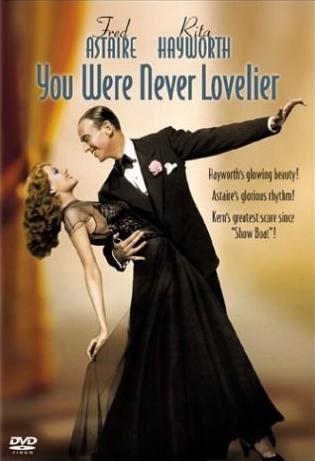- You Were Never Lovelier
Infobox Film | name = You Were Never Lovelier

caption =You Were Never Lovelier DVD cover
director =William A. Seiter
producer = Louis F. Edelman
writer = Carlos Olivari (story)
Sixto Póndal Ríos (story)
Michael Fessier
Ernest PaganoDelmer Daves
starring =Fred Astaire Rita Hayworth Adolphe Menjou Isobel Elsom Leslie Brooks
music =
cinematography =
editing =
distributor =Columbia Pictures
released =November 19 , 1942 (U.S. release)
runtime = 97 min
language = English
budget =
imdb_id = 0035583"You Were Never Lovelier" (
Columbia Pictures ) is a1942 Hollywood musical comedyfilm , set inBuenos Aires . It starredFred Astaire ,Rita Hayworth ,Adolphe Menjou andXavier Cugat , with music byJerome Kern and lyrics byJohnny Mercer . The film was directed byWilliam A. Seiter .This, the second of Astaire's outings with Hayworth, avoids wartime themes, and benefits from lavish production values – a consequence of the box-office success of the earthier "
You'll Never Get Rich ". Kern here created a memorable standard with "I'm Old Fashioned ", and there is a faultless trio of classic dance routines; but sugary sentimentalism enters, and rather eccentricart direction . Initially, Kern was unhappy about the selection of Cugat and his orchestra; however, when production was complete, he was so pleased with the band's performance that he presented him with a silver baton. Although Hayworth had a fine voice,Harry Cohn insisted on her singing being dubbed throughout byNan Wynn .The film follows the usual conventions established by Astaire in his earlier musicals, such as an anti-romantic first meeting between the two leads, a virtuoso dance solo for Astaire, a playful dance duet and a romantic dance duet.
Key songs/dance routines:
Dance director was
Val Raset , the one and only time he collaborated with Astaire, and his choreographic input into the film is unclear. According to Astaire’s biography, he worked out all the numbers with Hayworth while rehearsing above a funeral parlour. Although the setting is a Latin one, Kern felt unable to compose in this style, but Astaire was determined to continue his exploration ofLatin dance , which he did with the help of special arrangements by Cugat and Murphy, and the inspiration provided by the enthusiastic and talented Hayworth. This became an important counterbalance to Kern’s tendency to compose sweet, occasionally saccharine, melodies. Hayworth's performance here establishes her claim as one of Astaire’s foremost dance partners.* "Chiu Chiu": Cugat’s band performs this showpiece
samba with music and lyrics by Nicanor Molinare in front of Astaire.* "Dearly Beloved": Kern’s
ballad became a major hit for Astaire – who sings it here, and it was nominated for anAcademy Award for Best Original Song . Shortly after, Hayworth reprises the song with a brief but erotic dance, alone in her bedroom.* "Audition Dance": "One of my best solos" was Astaire's verdict on his first solo routine on the theme of Latin dance, celebrated for its comic inventiveness and dexterity. Astaire’s number also inspired
Jerome Robbins ’ solo Latin dance in the latter’s firstballet "Fancy Free", created in1944 .* "
I'm Old Fashioned ": A Kern melody, with Mercer’s lyrics mimed by Hayworth, inspires Astaire’s second Latin romantic partnered dance, and one of his best known. This dance was chosen by Jerome Robbins as the centerpiece to his ballet of the same name, created by him for theNew York City Ballet in1983 , as a tribute to Astaire.* "The Shorty George": A synthesis of American Swing or
Jive , and virtuoso tap dancing by Astaire and Hayworth, both in top form and exuding a sense of fun in an arrangement by Lyle "Spud" Murphy. The title refers to a popular dance step of the time, attributed to "George "Shorty" Snowdon" a championAfrican-American dancer at Harlem’s Savoy Ballroom and reputed inventor of theLindy Hop orJitterbug dance styles. Here, as in the "Pick Yourself Up " and "Bojangles of Harlem" numbers from "Swing Time ", Kern belied his claim that he couldn't write in the Swing style.* "Wedding in the Spring": Overly sweet and soppy number performed tongue-in-cheek by Cugat’s band.
* "You Were Never Lovelier": A Kern melody, sung by Astaire to Hayworth, with a celebratory dance reprise at the film’s end, initiated by an armour-suited Astaire falling off a horse, and shedding his knight’s armour, only to reveal himself in white tie and tails. According to Astaire, the original dance number that followed the song was cut from the film after the preview as the studio felt it "held up the story".
* "These Orchids": Cugat's band provides an orchestral serenade in rumba style to Hayworth outside her bedroom window with this Kern melody.
External links
*
References
*Fred Astaire: "Steps in Time", 1959, multiple reprints.
*John Mueller: "Astaire Dancing - The Musical Films of Fred Astaire", Knopf 1985, ISBN 0-394-51654-0
Wikimedia Foundation. 2010.
